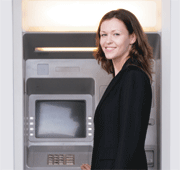13 August, 2009
category: Biometrics, Corporate, Education, Library
While usage is light, hand scanners are starting to make their presence felt on some college campuses
By Andy Williams, Associate Editor, Avisian Publications
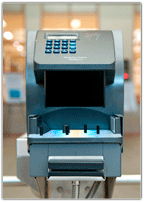 Biometrics aren’t exactly taking the college world by storm but it is gaining traction in some areas. While the technology can be expensive, some schools are finding uses that both aid in identification and, in light of the current budget crunches, recoup what otherwise might be lost income.
Biometrics aren’t exactly taking the college world by storm but it is gaining traction in some areas. While the technology can be expensive, some schools are finding uses that both aid in identification and, in light of the current budget crunches, recoup what otherwise might be lost income.
Most campus card providers offer biometrics as an option to their college clients. And most of these providers use what can only be described as the big biometric provider on campus, Ingersoll Rand.
“We’re on most campuses because we have a broad product line that includes door locking systems as well as biometric readers,” says Bob Bazemore, director, education solutions, Ingersoll Rand.
Bazemore estimates IR is on some 100 campuses, mostly in the U.S. Surprisingly, the biometric of choice isn’t a fingerprint reader but one that reads the hand geometry.
Read Winkelman, vice president of sales for colleges and universities at The CBORD Group, says biometrics is viable in certain situations. “We haven’t seen the demand for biometrics as the primary credential, but have seen it as a form of secondary authentication, usually in higher security areas, such as computer labs.” He says about ten CBORD schools have biometrics installed, nothing “a number are research institutions with very expensive equipment.”
Some CBORD schools do use a fingerprint reader, but it’s for employees and is used with CBORD’s point-of-sales system. “As with most POS terminals, registered operators log in to begin their shift. Often this is done with an employee card that is swiped. We have customers who use a fingerprint reader for this purpose instead. They register their fingerprint in the database and use it to log in. We have five or so customers using this application,” says Winkelman.
Heartland Campus Card Solutions can also offer fingerprint scanners if their clients want it, but none have asked for it yet, says Fred Emery, Heartland’s vice president and general manager. Some say there are privacy issues with fingerprints. “They’ve gone with the hand. It seems less obtrusive,” says Emery.
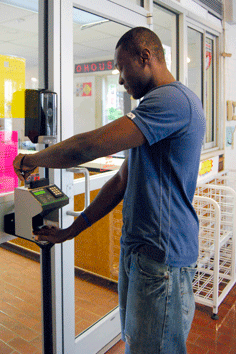 The University of Georgia has been using hand scanners since they were first created. The Athens, Ga.-based school has had lots of time to experiment with scanners and has had such scanners, and its different versions, in place for more than 35 years. The scanners are primarily used in food services, campus recreation and dorm access, says William McGee, manager of UGACARD Services at the university.
The University of Georgia has been using hand scanners since they were first created. The Athens, Ga.-based school has had lots of time to experiment with scanners and has had such scanners, and its different versions, in place for more than 35 years. The scanners are primarily used in food services, campus recreation and dorm access, says William McGee, manager of UGACARD Services at the university.
Obviously the university has upgraded its scanners since that first 1972 installation. “The first hand scanner was about the size of a 20-inch TV,” says McGee. “It’s a beast.” The company that first installed that scanner later became part of Ingersoll Rand. The university is now using IR’s HandKey 2 scanner.
The university requires either an ID card or the ID number to be physically entered in addition to the hand scan. The ID number is nine digits long. “It’s not a hard number to memorize. Most have it memorized in the first week,” says McGee of the school’s 37,000 students.
“Biometrics takes security to a new level,” says McGee. You’re dealing with something you have (the ID card or something you know (PIN) in addition to something you are. “Even if you knew my ID number, your chances of getting in with your hand is impossible and reader locks down after the third attempt,” he says.
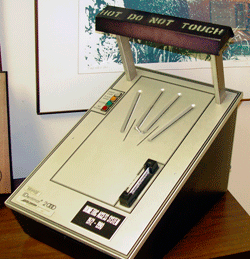 An Old hand reader once used by UGA.
An Old hand reader once used by UGA.As far as read times, 30 years ago it was probably in the three or four second range, but now it’s much less, says McGee. In addition the scanners have gone from a one-to-many comparison to one-to-one.
Dining services was the group that first brought it to campus. “They were looking for a better way to identify patrons than the meal token, something that could provide quick and easy access. We have an all-you-can-eat program, so whether you come once a day or 20 times a day, you can get service. With a hand scanner you don’t have to have staff to physically check the card,” says McGee.
He says the university upgraded to HandKey 2 because it provided “better read quality and an outline of the hand so students know where to place their hand. It also includes an antibacterial platen to cut back on germs,” adds McGee.
Even twins can’t fool a scanner
The university is also experimenting with different uses for the scanner. “We had a request from a faculty member who wanted to verify if the right students were taking a test.” When students come in, they perform a hand scan and swipe their card and the reader turns red or green so the professor can see at a glance if the student deserves to be there.
“This will prevent other students from taking the test. You can adjust the tolerance to where it’s very strict. We have twins who do not show up the same. We had a set that tried to share a meal plan, and that’s how we caught them,” says McGee.
A convenience for students
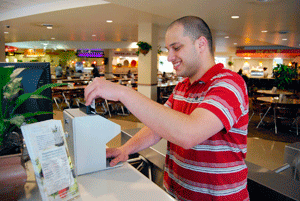 Colleges need a good cost saving reason to think about using the technology, says Emery. Budget shortages could be holding the hand scanning technology back because they are more expensive than a mag-stripe reader or PIN pad.
Colleges need a good cost saving reason to think about using the technology, says Emery. Budget shortages could be holding the hand scanning technology back because they are more expensive than a mag-stripe reader or PIN pad.
Two Heartland clients are Emory University, Atlanta, and Hofstra University, Long Island, N.Y. – have biometrics systems in place, says Emery. “They use hand geometry scanners from Ingersoll Rand integrated into our solution so they communicate to our access control software.”
For Emory University, hand scanners are about student convenience. The school uses them at one of its recreation facilities so students don’t have to carry a card to get in, says Emery.
At Hofstra, they were to increase security in some of the residence halls and entry ways. “They wanted to harden access to the dorms and to make sure a student couldn’t hand the card out the dorm window to another student for access,” Emery says.
For ease of use hand geometry is great, however, it’s not for all buildings. “If you go into a computer lab or library, a lot of campuses would feel it’s overkill. You can do more with a regular card, or card plus a PIN,” says Emery.
“A lot of people like (hand scanners) and would like to do it, it’s just a matter of practicality and cost. It’s very fast but not as fast as an RFID or mag- stripe read,” adds Emery.
Why hand scanners?
The speed of hand scanners make them a good fit for college campuses. “A fingerprint doesn’t work as well in a high volume capacities like you find at universities,” says Ingersoll Rand’s Bazemore. “You need to get a lot of people through very quickly.”
IR’s top scanner is the Schlage HandKey 2 used by both CBORD and Heartland schools. The only difference from Handkey 1 is the casing. The first version had a white metal housing while No. 2 has a polymer case which means it comes with a lower price tag. Even though it is more esthetically pleasing, it’s not as durable, says Bazemore. “It will last as long except in an abusive environment” which a university can tend to be. “The white metal casing, they don’t kick it but once,” laughs Bazemore.
The popular idea now is to use the card and then place a hand on the scanner. The scanner compares the students hand against a stored template, or mathematical representations, and performs a one-to-one match. The template can be stored locally on the device or on a network. Bazemore says the price of the scanner, which is basically a reader, is around $2,000, he says.
Many hand measurements, small file
When a student first enrolls a hand, the device takes a 3D photo that captures it from several angles, says Bazemore. “It takes about 90 different measurements and converts that to a 9-byte file. Later, when you put your hand on the scanner it only does a one-to-one match.” In other words, it checks the current scan against the store 9-byte file associated with the cardholder.
Bazemore says he’s seen no decline in schools wanting biometrics because of the recession. In fact, it may be driving schools to put in such programs. “They may be looking for tighter controls over their meal programs to make sue everyone is paying,” says Bazemore. “They’re trying to keep someone from giving his card to a buddy and two people coming through and shorting auxiliary services out of a fee. This stops all that.”
For a technology that’s 30-plus years old, which is a lifetime in this computer-driven age, it’s hard to imagine that biometrics on college campuses is still at the infant stage, meaning a smattering of schools here and there are actually using it.
CBORD’s Winkelman believes it’s not the cost so much as universities wondering if they really need two forms of identification. “It’s kind of the same story we’ve had with smart cards. There are some neat applications and some things they can do, but mag- stripe is so ubiquitous and easy to implement. When you talk about hand recognition, how many vendors are out there? A lot more are providing mag-stripe cards.”




